The Dream
Ojos del Salado is a peak that I have wanted to climb for a long time. In fact, it became one of my top three "dream climbs" back in 1984, at age 10, which is when I first read about the mountain. The other two dream climbs at the time were Muztag Ata and Aconcagua. Unlike Aconcagua however, Ojos del Salado seemed so mysterious and unknown. Dreams however, change over time and over the years I focused on other mountains in the world and never got close to Ojos del Salado.
Old dreams are eventually either fulfilled, never die, or die hard, so Ojos del Salado was always in the back of my mind somewhere and for a later date. That later date finally came in January 2016. Because of work, I can only get time off in the Northern Hemisphere winter. My thirteen year old son and I wanted to attempt something higher than we ever have before. Aconcagua came to mind, but that mountain has gotten more expensive and crowded over the years. There was also a rule in place that you had to be 14 years of age to climb it and my son was not 14 yet. Ojos del Salado seemed like the logical choice for our climb in the winter of 2015-2016.
![Ojos del Salado]() Ojos del Salado from the north.
Ojos del Salado from the north.Introduction and Preparation
Ojos del Salado, at 6893 meters (22,615 feet) is considered to be a fairly straightforward ascent for a mountain of its elevation. No mountain that high is to be taken lightly however, and any climb or attempt of Ojos del Salado required planning and preparation.
Ojos del Salado holds many records and accolades, some of which are second to other mountains. Some of them are as follows:
Ojos del Salado is the highest volcano in the world. It is the second highest mountain in the Western Hemisphere, the second highest mountain in the Southern Hemisphere, and the second highest mountain in the world outside Asia. It is also the second highest of the
Second Seven Summits and the highest of the
Volcanic Seven Summits. It is also the highest mountain in Chile.
The mountain sits in the heart of the Atacama Desert, which is considered to be the driest desert in the world. It is one of the most desolate and isolated places on earth, though since the area is rich in minerals (especially gold and copper), it is actually fairly easy to access for such a remote region.
The mountain can be climbed from the Chile side or the Argentina side. The Chile side is easier to get transport to. The Argentina side is said to be more scenic and is an easier climb. We chose the Chilean side since we could find transport to that side of the mountain.
Even though the mountain sits in the desert, high in the mountains storms are still fairly frequent. The area around Ojos del Salado is said to be one of the windiest places on earth. It isn't the technical difficulty that are the main challenges in these mountains, it is the elevation, cold, wind, isolation, and lack of water that provide the main challenges.
Kessler and I took almost a year to prepare for Ojos del Salado. We climbed more than one hundred mountains in the previous year, many of which were done in extremely cold and windy conditions. See our
2015 Trip Log if interested. We did a lot of fine tuning of our gear as well.
![Jacque Peak summit]() One of our preparation climbs in Colorado.
One of our preparation climbs in Colorado.
Since Ojos del Salado is such a big mountain, we didn't want to do it alone (my son was 13 years old and I found it prudent to have another adult along). I couldn't find any interested friends that could come with us, so we decided to hire a local to take us to the mountain. We would be on a "light guided" trip, meaning that we would have a companion and transportation, but that we would bring all our own gear and would be responsible for setting up our own tent, etc. We didn't need, nor did we really want to spend the money for a fully guided trip, so a light guided trip seemed the best way to fill in the gap and to have another adult along with us.
January 17: Valle Chico
After flying to Santiago and Copiapó the next morning, we met Fernando at the airport on January 16. In the afternoon of the 16th, Fernando asked us if we wanted to shop for our own food, or if he should do it. Since Kessler and I had forgotten our sleeping pads, we opted to go shopping for them, instead of with Fernando.
![Airport]() Copiapó Airport.
Copiapó Airport.
Copiapó is a fair sized city in the Atacama Desert at the foot of the Andes. It's economy is based on gold, silver, and copper mining. It looks similar to the area around Death Valley, and away from the river it is so dry that not even cactus will grow. Never the less, in March, there was a very rare rainstorm that flooded the town. It hasn't rained in town since then.
![Copiapó]() Copiapó.
Copiapó.
We left Copiapó in Fernando's Hilux for the dusty ride to Valley Chico.
In the afternoon, we were at Valle Chico, at a beautiful spring and oasis surrounded by canyon walls. Kessler and I hiked up the valley and explored around an old mining camp and some caves before returning to camp. We had a nice barbecue for dinner.
![Valle Chico]() Kessler hiking near Valle Chico.
Kessler hiking near Valle Chico.January 18: Laguna Santa Rosa
In the morning, Fernando drove us to the Laguna Santa Rosa. There were many flamingos in the lake. We also saw vicuñas and guanacos. We hiked around to the other side of the lake and climbed a small peak for the views.
The wind is relentless here and blows constantly. On the summit of the peak, many of the flat lying rocks were vertical became the wind had blown them that way!
We had good views of Tres Cruces, some of the highest mountains in South America.
![Flamingo and Tres Cruces]() A Flamingo in Laguna Santa Rosa. Tres Cruces is in the background.
A Flamingo in Laguna Santa Rosa. Tres Cruces is in the background.![Summit]() Kessler on the summit of an (un-named?) peak near Laguna Santa Rosa.
Kessler on the summit of an (un-named?) peak near Laguna Santa Rosa.![Siete Hermanos]() Siete Hermanos from Laguna Santa Rosa.
Siete Hermanos from Laguna Santa Rosa.January 19: Siete Hermanas
Today we climbed Siete Hermanas (also known as Siete Hermanos). We made pretty good time up to the summmit (4890 meters/16,043 feet). It was clear and the views were great. Kessler was the first one to the summit. We could see many volcanoes from the summit and the views were great.
![Siete Hermanos]() Enroute to Siete Hermanos
Enroute to Siete Hermanos![Resting]() Resting on Siete Hermanos
Resting on Siete Hermanos![Siete Hermanos]() Nearing the Summit of Siete Hermanos
Nearing the Summit of Siete Hermanos![Summit]() Kessler on the summit of Siete Hermanas.
Kessler on the summit of Siete Hermanas.
As always, the wind is relentless and blows constantly. It sucks the life out of everything. Nothing even decays or rots here, it simply dries, bakes, freezes, and mummifies.
The sun is so intense, that even though the temperature is not that hot, it feels very hot whenever the sun is out.
January 20: Laguna Verde
Today we traveled by truck to Laguna Verde (4300 meters/14,200 feet). The desert is very desolate along the way.
![Atacama Desert]() The incredibly desolate Atacama Desert. It is so dry here that not even cactus will grow. Arica, a major city in the desert gets an average of 0.02 inches of rain a year. By way of comparison, Death Valley, the driest place in the United States gets 118 times more rain. It would take more than one hundred years in Arica to get the amount of rain that Death Valley gets in one year. Although sometimes listed as such in some almanacs, Arica isn't even in the driest part of the desert. Some towns in the vicinity of San Pedro and Calama were settled more than 400 years ago and it still hasn't even rained once since the towns were settled. Even in the larger towns and cities, many children have only read about rain in school books and have never seen it.
The incredibly desolate Atacama Desert. It is so dry here that not even cactus will grow. Arica, a major city in the desert gets an average of 0.02 inches of rain a year. By way of comparison, Death Valley, the driest place in the United States gets 118 times more rain. It would take more than one hundred years in Arica to get the amount of rain that Death Valley gets in one year. Although sometimes listed as such in some almanacs, Arica isn't even in the driest part of the desert. Some towns in the vicinity of San Pedro and Calama were settled more than 400 years ago and it still hasn't even rained once since the towns were settled. Even in the larger towns and cities, many children have only read about rain in school books and have never seen it.
The lake is extremely salty and I tried to wash our clothes in it. That was a mistake. It made them stiff and salty. I washed them another three times in the fresh water hot springs, but they were still a little stiff. We also took some nice baths in the hot springs.
![Volcan Laguna Santa Rosa]() Volcan Laguna Santa Rosa from the Laguna Santa Rosa.
Volcan Laguna Santa Rosa from the Laguna Santa Rosa.![Mummified cow]() Mummified cow at Laguna Verde. It looks like it died fairly recently, but it actually died more than 70 years ago. The air is so dry and usually cold that it just dries out and freezes everything, so nothing really decays.
Mummified cow at Laguna Verde. It looks like it died fairly recently, but it actually died more than 70 years ago. The air is so dry and usually cold that it just dries out and freezes everything, so nothing really decays.
Setting up the tent in the strong wind was challenging. The wind always seems to blow here.
After dinner, Kessler and I walked west along the south shore of the lake to a freshwater spring and to some big cliffs made of volcanic tuff. There was one flamingo in the pool at the spring.
In the late evening, Kessler and I played UNO with the Russian expedition in their big dining tent. I wanted to ask them about joining them on a future expedition to Peak Lenin, but we only played cards. They gave us some chocolate as well. We ended up going to bed very late.
![Laguna Verde]() Laguna Verde. Cerro Ermitaño is in the background.
Laguna Verde. Cerro Ermitaño is in the background.January 21: Mulas Muertas
Today we set off for Mulas Muertas. We climbed it right from Laguna Verde. The summit of Mulas Mertas is actually a long way from the lake and extremely long day climb from there, so we only went up to the first false summit on the ridge. We could have climbed farther along the ridge, but it was supposed to be a rest day and we had to save our energy for Ojos del Salado. Since we were well above 5000 meters though, it made a good acclimatization climb.
Once again, it was very windy and my hat kept blowing off. We had some great views of Laguna Verde, Incahuasi, and many other volcanoes.
![Mulas Muertas]() Starting up Mulas Muertas.
Starting up Mulas Muertas.![Resting]() Resting part way up.
Resting part way up.![Mulas Muertas]() Hiking up Mulas Muertas. Laguna Verde is far below.
Hiking up Mulas Muertas. Laguna Verde is far below.![High on the Ridge]() High on Mulas Muertas.
High on Mulas Muertas.![Mulas Muertas]() High on Mulas Mertas.
High on Mulas Mertas.![Laguna Verde]() Laguna Verde from Mulas Muertas.
Laguna Verde from Mulas Muertas.
This area is very desolate. The Atacama Desert is probably the most desolate place I've seen that actually is populated in a few places (though not in this area). It's as if this region of the earth died long ago leaving nothing behind but the old bones and dust of the earth.
Dinner was disappointing. On this night, we regretted the decision of not doing our own food shopping. We had plain rice with a very few canned oysters thrown in. It was hard to force down the tasteless concoction at this altitude. The Russian expedition seemed to be eating well and we could only look at their food with envy.
January 22: Laguna Verde
Today was a planned rest day. Kessler and I walked around before walking to the fresh water stream at the west side of Laguna Verde. We saw one flamingo and a white bird. we explored some shallow caves.
The sun was really intense and felt hot, so we decided to find a cave that might be good for a rest. One of the caves had a rough floor and one had a sandy floor. Since it was so hot (surprising at this elevation), we took a rest and I even took a nap in the cave with a sandy floor.
In the afternoon, we did the same walk again with Fernando and one of his friends, but this time we climbed to the top of the cliffs that formed a small mesa-like peak. Fernandos friend free soloed a 5.8 wall, but I wasn't happy about it.
The climb up to the cliffs was very sandy and strenuous, but there were good views from the top.
Back at camp, the Russian expedition offered us dinner. We had a 1/2 portion and it sure was good. After that, we ate our other dinner in camp.
![Laguna Verde]() Laguna Verde from Mulas Muertas.
Laguna Verde from Mulas Muertas.![Nap]() Taking a nap in a shallow cave.
Taking a nap in a shallow cave.![Laguna Verde]() Above Laguna Verde.
Above Laguna Verde.![Sunset]() Sunset from Laguna Verde. The tents are from a Russian expedition.
Sunset from Laguna Verde. The tents are from a Russian expedition.January 23: Ojos del Salado Day 1
It was the first day of our attempt on Ojos del Salado. From 4900 meters elevation, we walked up to the Refugio Atacama at 5210 meters (17093 feet). We set up camp in the strong winds and setting up the tent was a challenge.
![Approach]() Kessler on the approach to Refugio Atacama.
Kessler on the approach to Refugio Atacama.January 24: Ojos del Salado Day 2
Today was a haul day. We carried gear up to Camp Tejos at 5837 meters (19150 feet). Unfortunately the refugio at camp was pretty dirty. At the refugio, we talked to one group consisting of two Americans and one German. They were to attempt the mountain the next day.
![Tres Cruces]() Tres Cruces as seen from the approach to Ojos del Salado.
Tres Cruces as seen from the approach to Ojos del Salado.![Penitentes]() Penitentes or snow spikes on Ojos del Salado.
Penitentes or snow spikes on Ojos del Salado.January 25: Ojos del Salado Day 3
In the morning, the Russian expedition, run by Alex Abramov got a detailed weather forecast by satellite phone and warned us about high winds for the next three days. Unfortunately, Kessler and I didn't have that many days to spare so we headed up towards camp Tejos. The Russians also headed up there, but after that they were going to retreat for four days and wait for better weather.
We also met the American/German Team. They were also retreating down the mountain to wait for better weather. That meant that we would have the mountain all to ourselves, though the conditions would not be ideal for a summit attempt. On the way up it was windy and cloudy and some of the mountains had some large lenticulars over them. We made it to Camp Tejos with no problems.
I had a slight cold, but breathing at the altitude of Camp Tejos was a nightmare at that altitude, at least during the night. I also coughed a lot.
I was able to eat two cup o soups and Kessler was able to eat one. Even though we were to get up early, the night was still long and I didn't get hardly any sleep. Kessler seemed to get more. I don't have any desire to sleep that high again anytime soon!
![Load Carrying]() Load carrying to Camp Tejos on Ojos del Salado.
Load carrying to Camp Tejos on Ojos del Salado.![Mulas Muertas]() Mulas Muertas from high on Ojos del Salado.
Mulas Muertas from high on Ojos del Salado.January 26: Ojos del Salado Day 4
After a rough night of coughing, my alarm went off at 2 AM. Since it was very windy and since Kessler and I were both coughing, we decided to postpone the summit attempt for a couple hours. I reset the alarm for 4 am and we went back to bed. When the alarm went off at 4, we started packing up and getting ready. Fernando didn't think that it was a good idea to make the attempt since we were coughing and it was very windy and cold (cold enough to freeze all the water jogs inside), but it was clear and Kessler and I wanted to see how high we could make it (we didn't expect to make the summit with the current conditions).
After a small breakfast, at 5 AM we started up the mountain slowly in the cold and wind. The moon was almost full, so we turned off the headlamps just before starting.
Although we were wearing the same clothing, Kessler had trouble keeping warm in the strong winds. The wind was so strong that it was constantly blowing dust and pea sized rocks into our faces. I had more "body insulation" to keep me warm. We decided to keep on pushing up slowly. We stopped briefly at 6000 meters and again at 6220 meters (20,407 feet), which is about the same time the sun came up (around 7 AM). We were near the edge of the "glacier" though it appears to be more of a permanent icefield.
The views were really nice and the sky was clear, but the wind sucked away any heat our bodies could generate, so we decided to retreat. Our summit attempt was over. We had one day to spare, but none of us wanted to suffer through another night at Camp Tejos and the conditions weren't supposed to improve the next day anyway. The old dream of climbing Ojos del Salado was dead.
We hiked rather quickly down the mountain and to Tejos. We packed up our stuff and then descended to Refugio Atacama where we packed up the tent and retrieved the rest of the gear we left behind. We said goodbye to the Russian expedition and got in the Hilux (Toyota Truck) for the long ride down to lower altitudes. Fernano was driving and we actually drove all the way to Bahia Inglesa. It was quite a change to go from 6220 meters (20,407 feet) to sea level on the same day! After checking into the hotel, we walked around a little and rested.
![Ojos del Salado]() Photo shot from 20,407 feet/6220 meters on Ojos del Salado. This was just before sunrise and it was freezing cold.
Photo shot from 20,407 feet/6220 meters on Ojos del Salado. This was just before sunrise and it was freezing cold.![Resting]() Resting high on Ojos del Salado. It was too cold to rest for long.
Resting high on Ojos del Salado. It was too cold to rest for long.![Descending]() Descending from high on Ojos del Salado.
Descending from high on Ojos del Salado.![Mulas Muertas]() Mulas Muertas from Ojos del Salado.
Mulas Muertas from Ojos del Salado.![Mulas Muertas]() Another shot of Mulas Muertas from Ojos del Salado.
Another shot of Mulas Muertas from Ojos del Salado.January 27: Bahia Inglesa
Kessler and I did a hike along the beach in either direction from Bahia Inglesa. We saw much sea life, including some large crabs.
![Bahia Inglesa]() Bahia Inglesa made a well deserved rest and recovery spot.
Bahia Inglesa made a well deserved rest and recovery spot.January 28: El Morro
After walking along the beaches for a while, Kessler and I climbed the highest hill around, known as El Morro. We had a nice seafood dinner.
![Dinner Time]() Fresh octopus for dinner.
Fresh octopus for dinner.January 29: Cerro Santa Lucia
Kessler and I made the short climb up to the Cerro Santa Lucia in Santiago. The views were great. We also did a lot of other walks in town.
![Cerro Santa Lucia]() Climbing the stairs to the summit of Cerro Santa Lucia.
Climbing the stairs to the summit of Cerro Santa Lucia.![Santiago]() Santiago from Cerro Santa Lucia.
Santiago from Cerro Santa Lucia.
On January 30, we walked 5 kms (3 miles) each way to the Sky Tower and went to the top. We also walked around town before heading for the airport and flying home in the evening.
Conclusion and Closure
I have been asked if I am ever going back to complete the climb of Ojos del Salado. Although I'm glad that we went, I don't think I will. There are so many other mountain in the world calling my name and life is short.
This area is very desolate and even a desert rat like me longed for greenery. Ojos del Salado is interesting in a certain way, but it's just not as beautiful as some of other mountains on earth or in the Andes. It doesn't even look like a volcano and is a rather shapeless chaotic pile of rocks and dust. It lacks the symmetry of peaks such as Cotopaxi and the ruggedness of the Cordillera Blanca. The wind blows relentlessly, sucking the life and moisture out of everything and desiccating everything it touches. The sun is intense.
Whether one believes in the Bible or not, there is one verse which describes describes this place well:
"And the earth was without form, and void; and darkness was upon the face of the deep".
The above verse (Genesis 1:2) describes Ojos del Salado perfectly.
Although I have been dreaming of climbing Ojos since 1984, and since the age of ten years old, the dream has died a hard death. We didn't reach the summit, but the clear skies and extreme desolation will always be remembered, as will the experience. I also got to spend the time with my son. I didn't even get as high as I had climbed on other mountains previously, but it was and altitude record for Kessler.
I consider the chapter of Ojos del Salado to be closed in my life.








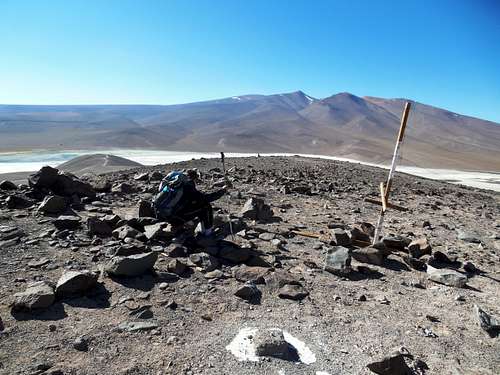


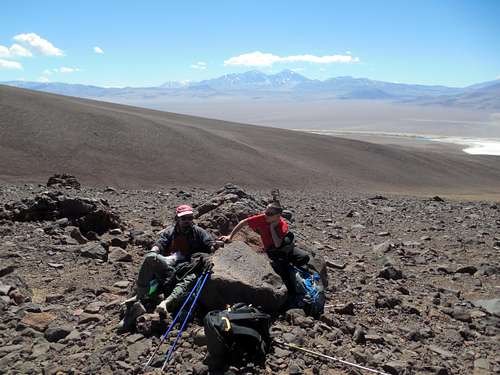







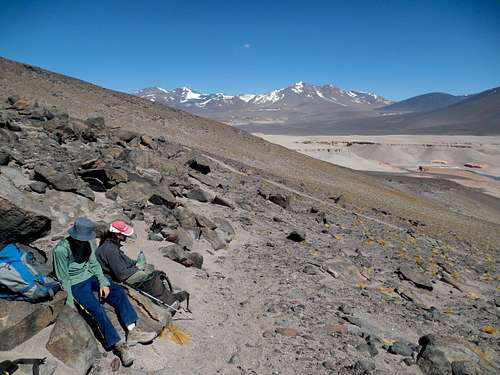



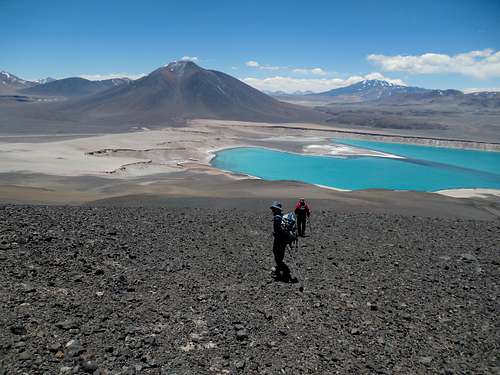

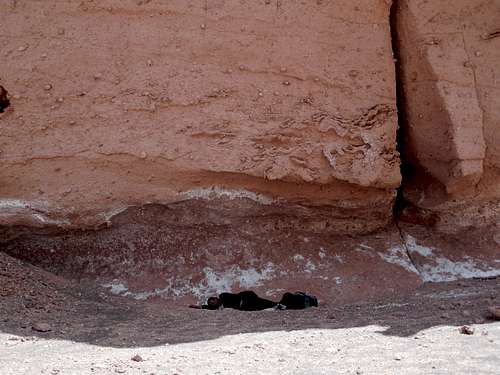




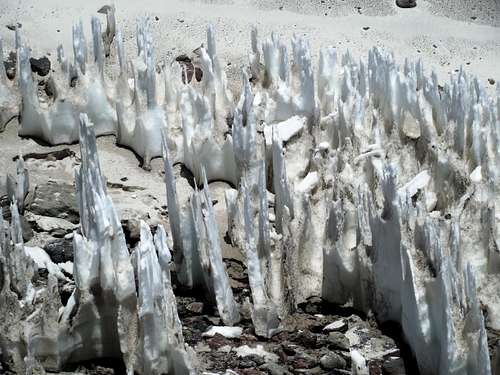







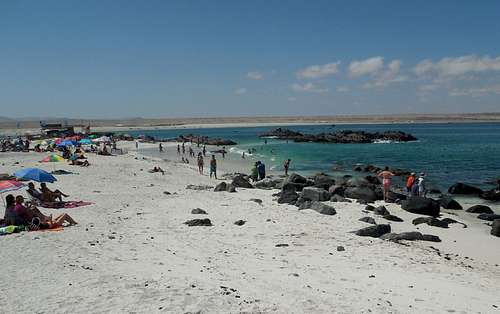


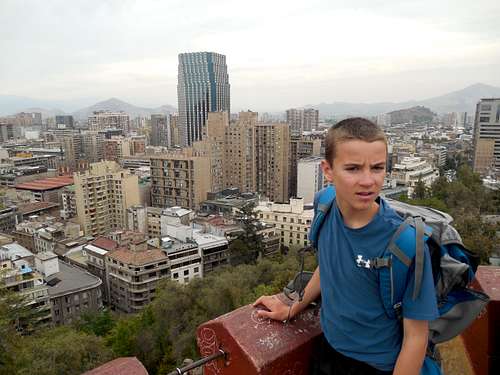





Comments
Post a Comment